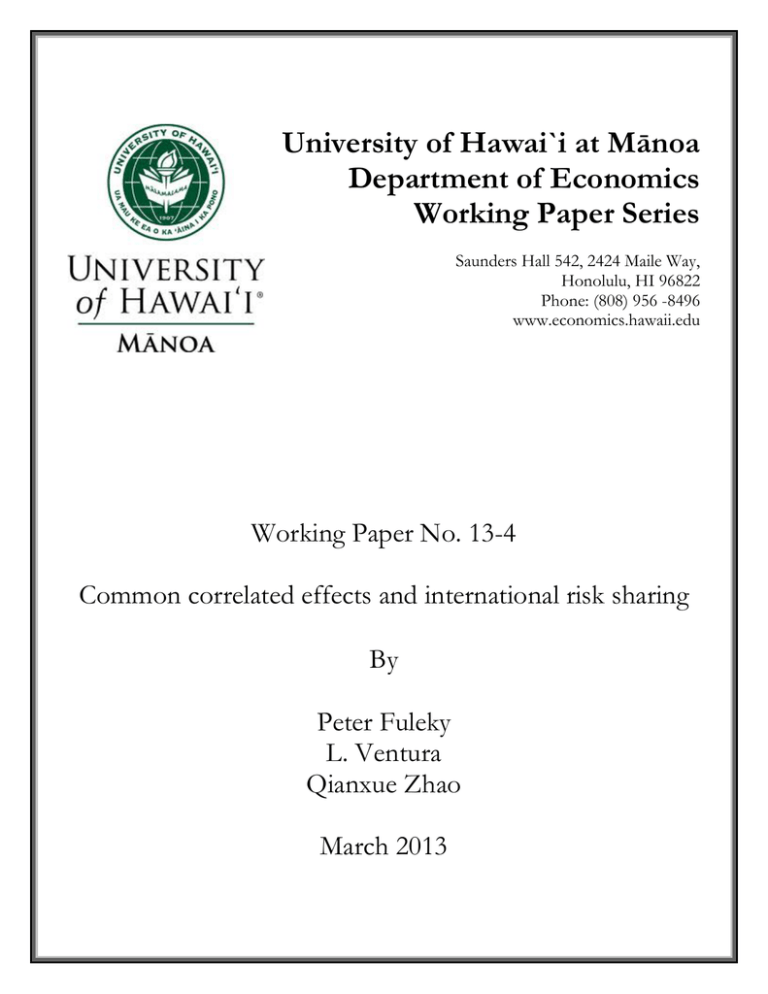University of Hawai`i at Mānoa Department of Economics Working Paper Series
advertisement

University of Hawai`i at Mānoa Department of Economics Working Paper Series Saunders Hall 542, 2424 Maile Way, Honolulu, HI 96822 Phone: (808) 956 -8496 www.economics.hawaii.edu Working Paper No. 13-4 Common correlated effects and international risk sharing By Peter Fuleky L. Ventura Qianxue Zhao March 2013 Common correlated effects and international risk sharing *P. Fuleky , ** L. Ventura, ***Q. Zhao *UHERO and Department of Economics, University of Hawaii at Manoa **Department of Economics and Law, Sapienza, University of Rome *** Department of Economics, University of Hawaii at Manoa Preliminary and incomplete version March 1, 2013 Abstract International risk sharing has been among the most actively researched areas of macroeconomics for the last two decades. Empirical contributions in this field make extensive use of so called ”consumption insurance” tests evaluating the extent to which idiosyncratic shocks in income get transferred to consumption. A prerequisite of such a test is the isolation of country specific variation in the data. We show that the cross-sectional demeaning technique frequently used in the literature is in general inadequate to eliminate global factors from a panel data set, and can lead to misleading inference. We argue that international risk sharing tests should instead be based on a method that more reliably deals with global factors. We claim and illustrate in our empirical application that the fairly simple common correlated effects estimator for cross-sectionally dependent panels introduced by Pesaran (2006), and Kapetanios et al. (2010) is a tool that satisfies this requirement. Keywords: Panel data, Cross-sectional dependence, International risk sharing, Consumption insurance JEL codes: C23, C51, E21, F36 1 1 Introduction Since the early contributions by Cochrane (1991), Mace (1991), and Obstfeld (1994), various tests of consumption risk sharing have been presented in the literature. A wide range of theoretical and empirical studies has examined the extent to which idiosyncratic risks are smoothed across regional or national economies through channels such as capital and credit markets, fiscal policies, and others. These tests were also used to assess the role of financial globalization in shaping the degree of risk sharing across nations. A prerequisite for these risk sharing (or consumption insurance) tests is a testable implication derived from the solution of a planner’s or competitive agents’ maximization problem in complete markets, that is, when it is possible to redistribute wealth or income (hence, consumption) across all date-event pairs. The solution to those problems reveals that under market completeness marginal utility growth is equalized across agents, and therefore may depend on aggregate factors but not on individual shocks. Assuming CRRA utility functions, the risk sharing hypothesis can be tested by estimating the following equation cit = αi + γi c̄·t + βi xit + εit , i = 1 . . . N, t = 1 . . . T , (1) where cit is a consumption measure for country i, c̄·t is an aggregate measure of consumption, and xit is an idiosyncratic variable. Market completeness implies γi > 0 and βi = 0. If the discount factors and the coefficients of relative risk aversion are taken to be equal across countries (quite a heroic assumption), the coefficients γi can be shown to take a unit value. That this is generically the case is quite unlikely, and awaits empirical evidence1 . Nevertheless, most papers in the field have built on these assumptions, under which equation (1) becomes cit − c̄·t = αi + βi xit + εit . (2) In virtually all macroeconomic implementations of equation (2), the generic variable xit containing idiosyncratic shocks is replaced by a proxy for idiosyncratic income, which in turn is calculated as a difference between the individual country’s income and a measure of aggregate income. With these modifications the tested relationship becomes cit − c̄·t = αi + βi (yit − ȳ·t ) + εit , (3) where yit is an income measure for country i, and ȳ·t is a measure of aggregate income. Equation (3) is the basis for several recent influential empirical studies, such as Sorensen and Yosha (2000), Giannone and Reichlin (2006), Sorensen et al. (2007), and Kose et al. (2009) among others. In these studies, the consumption and income measures entering the analysis are consumption growth and real gross domestic product (GDP) growth, respectively. Correspondingly, βi is interpreted as the effect of idiosyncratic real GDP growth on idiosyncratic consumption growth in country i, or as the extent of the departure from perfect risk sharing. If the c̄·t and ȳ·t aggregates represent cross-sectional means, then the differencing operations in equation (3) will produce crosssectionally demeaned variables. Some studies (for example Asdrubali et al. (1996), Lewis (1997), Sorensen and Yosha (1998), and Fratzscher and Imbs (2009)) replace the explicit cross-sectional demeaning in equation (3) by an implicit one by including a time dummy in the pooled regression cit = αi + dt + βyit + εit , (4) where dt is a time dummy. 1 Notice, however, that Obstfeld (1989) only found weak evidence against this hypothesis with respect to some relatively homogeneous countries, such as Germany, Japan and the United States. 2 In an alternative approach, Crucini (1999) and Artis and Hoffmann (2007) derive testable implications for the case where individual countries pool part or all of their income (see Shiller, 1995). They model country specific income as a mixture of domestic real GDP level and pooled real GDP level of participating countries, and obtain the test equation cit − c̄·t = αi + β(yit − ȳ·t ) + εit . (5) Because the variables enter their model in levels, their results reflect the scale of long run international risk sharing. Both Crucini (1999) and Artis and Hoffmann (2007), derive their results in the perfectly symmetric case where all countries are equal. By relaxing this restriction and allowing countries to be heterogeneous in terms of their economies’ size and in terms of their share of pooled income, we obtain the more general model cit − γic c̄·t = αi + βi (yit − γ̃iy ȳ·t ) + εit , or cit = αi + γic c̄·t + βi yit + γiy ȳ·t + εit , (6) where, as before, the βi coefficient measures the extent to which idiosyncratic shocks to income are channeled into domestic consumption. We argue in the sequel that consumption insurance tests should be based on estimating equation (6) as opposed to equations (3) or (4) because the latter suffer from inadequate handling of cross-sectional dependence and could produce misleading inference. Specifically, risk sharing tests require separation of idiosyncratic shocks from global ones, but simple cross-sectional differencing with respect to an aggregate measure is insufficient for this purpose because it imposes the overly restrictive assumption of a unit coefficient on the aggregate measure across all countries. In Section 2 we describe the common correlated effects (CCE) estimator of Pesaran (2006), which was shown to be an effective tool for eliminating common factors from linear relationships in heterogeneous panels, and is especially practical for estimating the link between idiosyncratic fluctuations, as in international risk sharing tests. Section 3 introduces our empirical strategy, Section 4 discusses the results, and Section 5 concludes. 2 The common correlated effect estimator The international risk sharing hypothesis postulates that consumption across countries follows a similar pattern, and deviations from this pattern cannot be predicted by idiosyncratic explanatory variables. The presence of a similar pattern across countries can be tested by the cross-sectional dependence (CD) statistic of Pesaran (2004). This test is based on the pairwise correlation of unitby-unit OLS residuals, and has been shown to have good finite sample properties in heterogeneous panels. If cross-sectional independence is rejected, the co-movement of variables across countries can be modeled through common factors, and the idiosyncratic components can be obtained by an orthogonal projection of the data onto the common factors. These idiosyncratic components can then be tested for predictability. Pesaran’s (2006) common correlated effects (CCE) estimator, which he proposed to deal with dependencies across units in heterogeneous panel, is an ideal tool for estimating the idiosyncratic effects, βi . The CCE estimator lends itself to this task because it accounts for common factors, such as global cycles, allows for individual specific effects of these factors, and produces coefficient estimates based on idiosyncratic fluctuations in the data. Specifically, the CCE estimator asymptotically eliminates the cross-sectional dependence in the panel regression cit = αi + βi yit + uit , i = 1, 2, . . . , N , t = 1, 2, . . . , T , (7) where cit = log(Cit ), yit = log(Yit ), with Cit and Yit being the level of a consumption measure and the level of an income measure, respectively. The coefficients βi represent the elasticities of 3 consumption with respect to income for each country. Alternatively, if the risk sharing hypothesis is tested with growth rates, cit = ∆ log(Cit ), yit = ∆ log(Yit ), the βi coefficients represent marginal effects. The dynamics and the common unobserved factors are modeled in the error terms uit . In particular, uit is assumed to have the following structure uit = γi0 ft + it , (8) where ft is an m × 1 vector of unobserved common effects with individual specific loading vector γi , and it are the individual-specific (idiosyncratic) errors assumed to be distributed independently of yit and ft . However, the it are allowed to be weakly dependent across i, and serially correlated over time. The CCE estimator is based on the assumption that the regressor, yit , is generated as yit = ai + λ0i ft + vit , (9) where ai is an individual effect, and λi is a m × 1 loading vector. The idiosyncratic component vit is distributed independently of the common effects and across i, but is assumed to follow a covariance stationary process. The error term in (7), uit , is allowed to be correlated with the regressor, yit , through the presence of the factors in both, and failure to account for this correlation will generally produce biased estimates of the parameters of interest. Pesaran (2006) suggested using cross section averages of cit and yit to deal with the effects of the unobserved factors. His CCE estimator is defined as, β̂i = (yi0 M̄ yi )−1 yi0 M̄ ci , (10) where yi = (yi1 , yi2 , . . . , yiT )0 , ci = (ci1 , ci2 , . . . , ciT )0 , and M̄ = IT − H̄(H̄ 0 H̄)−1 H̄ 0 with H̄ = (ι, ȳ, c̄), and ι is a T × 1 vector of ones. ȳ is a T × 1 matrix of cross-sectional means of the regressor, and c̄ is a T × 1 vector of cross-sectional means of the dependent variable. The CCE estimator is equivalent to ordinary least squares applied to an auxiliary regression that is augmented with the cross-sectional means of the variables cit = αi + βi yit + γic c̄t + γiy ȳt + uit , (11) where γic and γiy are the individual specific loading coefficients of average consumption and average income, respectively. That is, the β̂i coefficient estimates reflect the effect of income on consumption after controlling for common factors in the data. While Pesaran (2006) derived the CCE estimator for stationary variables and factors, Kapetanios et al. (2010) proved that the CCE estimators are consistent regardless of whether the common factors, ft , are stationary or non-stationary. In the latter case, cit , yit , and ft are cointegrated if it (in equation 8) is stationary. The authors also showed that under a random coefficient model, the mean of the CCE slope coefficient estimates is consistent for any number of unobserved factors. The CCE mean group estimator (CCEMG) is a simple average of the individual CCE estimators, βi , N 1 X β̂CCEM G = β̂i . (12) N i=1 When the slope coefficients, βi , are homogeneous, efficiency gains can be achieved by pooling observations over the cross section units. Pesaran (2006) developed such a pooled estimator N N X X β̂CCEP = ( yi0 M̄ yi )−1 yi0 M̄ ci . i=1 i=1 4 (13) Note that in equation (13) the observations are pooled after a unit-by-unit orthogonal projection onto the cross-sectional means. That is, the CCEP estimator allows for idiosyncratic loadings, γic , γiy , while estimating a common slope coefficient for the variable of interest, β. This can also be seen by breaking down the CCE estimation algorithm into two stages. In the first stage, the common effects are filtered out from the data by regressing each variable on the cross-sectional averages of all variables in the model y c cit = αi,c + γi,c c̄t + γi,c ȳt + εcit , (14) y c yit = αi,y + γi,y c̄t + γi,y ȳt + εyit . (15) In the second stage, the CCE estimate of an individual βi is obtained by regressing the residual ε̂cit , capturing idiosyncratic consumption, on the residual ε̂yit , capturing idiosyncratic income. Alternatively, β̂CCEP is obtained by a pooled regression of ε̂cit on ε̂yit . The CCE estimator nests the partial pre-filtering discussed by Obstfeld (1994), where each variable is regressed only on its own cross-sectional mean in the first stage. However, the restriction imposed by partial pre-filtering is inappropriate if income or consumption at the country level is affected by both types of global shocks. Therefore, regressing each variable only on its own cross-sectional mean in the first stage may be inadequate to control for cross-sectional dependence.2 The conventional approach for testing the international risk sharing hypothesis is based on subtracting worldwide aggregates from country level variables cit − ct = αi + βi (yit − yt ) + εit , i = 1, 2, . . . , N , t = 1, 2, . . . , T . (16) However, cross-sectional demeaning imposes unit loading coefficients on the aggregates, which is inappropriate if the impact of global trends varies across countries. As argued in the introduction, even in the presence of full risk sharing, we should expect unit loading factors on aggregate consumption if and only if countries had equal coefficients of risk aversion and equal discount factors. The CCE estimator admits both simple and weighted cross-sectional averages in the M̄ matrix. However, unequal weights may distort inference if they overstate the importance of outliers in the cross-sectional distribution of the data. For example, if a variable of interest is in per capita terms, each country could be weighted by its population share, so that the aggregate becomes a global per capita measure N X i=1 (Cit ∗ wit ) = C̄t , wit = Nit , i = 1, 2, . . . , N , t = 1, 2, . . . , T , Nt (17) where C stands for consumption per capita, and N stands for population. This weighting scheme overweighs countries with large population. If some of these countries are atypical, inference will be distorted. Specifically, if the proxies for the common factors are biased towards outliers, the CCE procedure will not be able to eliminate cross-sectional dependence in the panel. Furthermore, most macroeconomic time series, such as consumption and income, require a log-transformation before being fed to linear models. Such non-linear transformation will affect the location of the aggregate measure relative to the distribution of the individual country level variables, and further distort inference. These complications can be avoided if the cross-sectional means entering the M̄ matrix are obtained by applying simple averages to log-transformed country level series. 2 Obstfeld (1994) noticed that regressing each country’s consumption on aggregate consumption often generated non stationary residuals, but did not impute this to the presence of left over common correlated effects. 5 Consistent estimation of the model parameters requires that the regression residuals be stationary. The appropriate unit root test should take into account cross-sectional dependence because, if not controlled for, it distorts inference (Banerjee et al., 2004; Gengenbach et al., 2010). Rejection of a unit root in the CCE residuals implies that the non-stationary variables in the model and the unobserved factors are cointegrated. In the next section we describe our empirical model and report estimation results. 3 Data and results Our analysis is based on annual data that we obtained from the Penn World Tables, version 7.1, released in November 2012 (Heston et al. (2012)). This is a comprehensive dataset, covering more than 170 countries over a fairly long time span, and we selected the period 1970 - 2010, in order to maximize the number of countries with continuously available data in our panel. All values are expressed in real terms in a common currency, so as to make comparisons across countries and time feasible. The analyzed series are comparable to those in other datasets. For example, growth rates of real GDP and real final consumption almost perfectly match those in the last release of the World Bank’s World Development Indicators. From the PENN World Tables dataset we use the following variables: purchasing power parity converted GDP per capita and consumption per capita at 2005 constant prices (Laspeyres), and population. Table 1 and 2 display the cross-sectional mean of βi across countries and residual diagnostic tests for three approaches of dealing with cross-sectional dependence: CCE estimation, cross-sectional demeaning, and partial pre-filtering. For each method, we perform regressions with data in levels and in first-differences. The results in Table 1 are based on global trend approximations by equally weighted cross-sectional averages, whereas those in Table 2 are based on population weighted crosssectional averages. The lower panels of the tables illustrate the effect of excluding the Great Recession on the estimates by truncating the sample. For each regression, we perform residual diagnostics to ensure that the results are not spurious. We test the residuals for cross-sectional dependence using the CD statistic proposed by Pesaran (2004). If the CD test rejects the null hypothesis of cross-sectional independence, we apply the CRM A method of Sul (2009) to test for unit roots in the residual common factors. We also test the idiosyncratic components of the residuals for unit roots using the CIP S statistic of Pesaran (2007). The rejection of the CD test for the residuals in all demeaned and pre-filtered regressions indicates that these methods are not able to fully remove cross-sectional dependence from the variables. This also remains the case when the common trends are approximated by population weighted crosssectional averages. Moreover, the fact that even the CCE residuals are cross-sectionally dependent under the population weighting scheme suggests that some countries with large population are not typical in terms of risk sharing. Therefore, as explained in Section 2, population weights are inappropriate for the approximation of common factors in per capita GDP and consumption. c and γ y in the first stage A quick inspection of Figure 1, illustrating the distribution of γi,c i,y regressions (14) and (15), reveals that these loading coefficients vary sharply across countries: they are not equal to one, the value imposed by the demeaning method. Similarly, Figure 2, y y illustrates the distribution of the cross-loading coefficients γi,c and γi,c ; they are not equal to zero, the value imposed by pre-filtering. The constraints imposed by demeaning and pre-filtering leave these estimators misspecified, and as a result these methods are incapable of filtering out the common factors from the panels. In all cases where the regression is based on variables in levels and the CD test rejects cross 6 sectional independence of the residuals, the CRM A test implies that the common factors remaining in the residuals contain unit roots, and therefore the results are spurious. In regressions with stationary, differenced data, residual common factors will cause bias in the estimated coefficients due to the correlation between the residual and the regressors. In general, our diagnostic tests indicate that only the CCE estimator based on simple averaging yields statistically acceptable results. Figure 3 illustrates the distribution of individual βi ’s across estimation techniques. It is immediately obvious that there is a remarkable heterogeneity among countries in terms of their risk-sharing coefficients, both in levels (long run) and in differences (short run). Correspondingly, the rejection of Pesaran and Yamagata’s (2008) test of parameter homogeneity implies that pooled estimation is inappropriate. In line with earlier studies, our estimation results indicate that, on average, consumption tends to be affected by idiosyncratic risks in both the short and the long-run, but the extent of risk-sharing tends to be higher in the short run. In the long-run, the fraction of unsmoothed cross sectional variation in GDP channelled to consumption is above 0.80, while it is about 0.70 in the short run. However, we should exercise caution in comparing these two figures, as a more appropriate assessment of the long term and the short term risk sharing coefficients should be embedded in an error correction model, as highlighted in Leibrecht and Scharler (2008). We will not pursue this approach here, as it goes beyond the scope of our analysis. The similarity of the mean-group estimates across estimation methods conceals some sizable differences in the country specific estimates across methods. For the data entering the analysis in log-levels, the estimated coefficients under the demeaning method are significantly different from the CCE ones for about 50% of the countries, including Australia, Austria, Belgium, Denmark, Greece, India, Japan, Netherlands, New Zealand, Norway, USA. Thus, the CCE and the traditional demeaning method to assess the degree of risk sharing yields remarkably different conclusions for these countries. In Table 3 and 4, more than 95% of the country-specific βCCE estimates are significantly different from zero (151 out of 158), which suggests that these countries have incomplete markets. In fact, over one-third of countries exhibits dis-smoothing behavior with βCCE > 1. By contrast, the βDEM estimates obtained by the widely used demeaning methodology imply that a different set of countries is perfectly insured, and that there is a greater portion of countries with uninsured consumption (155 out of 158). The lack of risk sharing is also apparent when the estimates are obtained from log-differenced data: about 90% (142 out of 158) of βCCE∆ estimates is significantly different from zero, whereas this portion is closer to 87 % (138 out of 158) for βDEM ∆ . As in the long-run, the set of countries or regions exhibiting dis-smoothing behavior does not perfectly overlap across methods. Let us now focus on the results obtained from the consistent CCE method only and look at country-specific behavior regarding risk-sharing. First, in terms of the number of countries, the extent of perfect risk sharing is higher in the short run. Also, there is a large group of countries which has over 50 % higher coefficient estimates in the long-run. Second, there are fewer countries with dis-smoothing behavior in the short-run. Still, there are some countries that show dis-smoothing behavior both in the short and the long run, such as the Bahamas, Barbados, Bermuda, Burkina Faso, China, Cuba, Djibouti, El Salvador, Ethiopia, Guinea, Hungary, Nepal, Nigeria, Sudan. Finally, countries such as Panama, Iraq, Tanzania are perfectly insured in both short and long run. 7 4 Conclusion International risk sharing tests are usually based on the premise that under complete markets country specific consumption should not be affected by idiosyncratic income shocks. A prerequisite of such a test is the isolation of country specific variation in the data. We show that cross-sectional demeaning, while frequently applied in the literature, is in general insufficient to eliminate crosssectional dependence and common factors from a panel data set. Inadequate handling of crosssectional dependence can lead to misleading inference: the correlation of residual common factors with the regressors leaves the least square estimate biased, and if the residual common factor contains a unit root, the regression results are invalid. Our results indicate that a partial prefiltering of the data suggested by Obstfeld (1994) is also insufficient to eliminate the cross-sectional dependence in the panel. We show that a more statistically appropriate approach is the CCE methodology of Pesaran (2006) and Kapetanios et al. (2010) that controls for global trends, and focuses on the estimation of the coefficients of consumption risk sharing. In our empirical example, we contrast the spurious estimates based on a cross-sectionally demeaned data set with the estimates obtained by the CCE approach. Although the mean group estimates are similar, the country specific estimates vary widely across estimation methods. Because cross-sectional demeaning may yield invalid results and erroneous conclusions, international risk sharing tests should be based on a method that more reliably deals with global factors. We argue and illustrate in our empirical application that the fairly simple CCE estimator is a tool that satisfies this requirement. 8 References Artis, M. and Hoffmann, M. (2007). The home bias and capital income flows between countries and regions. CEPR Discussion Papers, (5691). Asdrubali, P., Sorensen, B. E., and Yosha, O. (1996). Channels of interstate risk sharing: United States 1963-1990. The Quarterly Journal of Economics, 111(4):1081–1110. Banerjee, A., Marcellino, M., and Osbat, C. (2004). Some cautions on the use of panel methods for integrated series of macroeconomic data. The Econometrics Journal, 7(2):322–340. Cochrane, J. H. (1991). A simple test of consumption insurance. Journal of Political Economy, 99(5):957–76. Crucini, M. J. (1999). On international and national dimensions of risk sharing. The Review of Economics and Statistics, 81:73–84. Fratzscher, M. and Imbs, J. (2009). Risk sharing, finance, and institutions in international portfolios. Journal of Financial Economics, 94(3):428–447. Gengenbach, C., Palm, F., and Urbain, J. (2010). Panel unit root tests in the presence of cross-sectional dependencies: Comparison and implications for modelling. Econometric Reviews, 29(2):111–145. Giannone, D. and Reichlin, L. (2006). Trends and cycles in the euro area: how much heterogeneity and should we worry about it? Working Paper Series, European Central Bank, (595). Heston, A., Summers, R., and Aten, B. (2012). Penn world table version 7.1. Center for International Comparisons of Production, Income and Prices. Kapetanios, G., Pesaran, H., and Yamagata, T. (2010). Panels with nonstationary multifactor error structures. Journal of Econometrics. Kose, M. A., Prasad, E. S., and Terrones, M. E. (2009). Does financial globalization promote risk sharing? Journal of Development Economics, 89(2):258–270. Leibrecht, M. and Scharler, J. (2008). Reconsidering consumption risk sharing among oecd countries: some evidence based on panel cointegration. Open Economies Review, 19(4):493–505. Lewis, K. K. (1997). Are countries with official international restrictions ’liquidity constrained’ ? European Economic Review, 41(6):1079–1109. Mace, B. J. (1991). Full insurance in the presence of aggregate uncertainty. Journal of Political Economy, 99(5):928–56. Obstfeld, M. (1989). How integrated are world capital markets: Some new tests. in debt, stabilization and development: Essays in memory of carlos diaz-alejandro., National Bureau of Economic Research, Inc. Obstfeld, M. (1994). Are industrial-country consumption risks globally diversified? NBER Working Papers 4308, National Bureau of Economic Research, Inc. Pesaran, M. (2004). General diagnostic tests for cross section dependence in panels. CESifo Working Paper Series No. 1229; IZA Discussion Paper No. 1240. 9 Pesaran, M. (2007). A simple panel unit root test in the presence of cross-section dependence. Journal of Applied Econometrics, 22(2):265–312. Pesaran, M. and Yamagata, T. (2008). Testing slope homogeneity in large panels. Journal of Econometrics, 142(1):50–93. Pesaran, M. H. (2006). Estimation and inference in large heterogeneous panels with a multifactor error structure. Econometrica, 74(4):pp. 967–1012. Shiller, R. (1995). Aggregate income risks and hedging mechanisms. The Quarterly Review of Economics and Finance, 35(2):119–152. Sorensen, B. E., Wu, Y.-T., Yosha, O., and Zhu, Y. (2007). Home bias and international risk sharing: Twin puzzles separated at birth. Journal of International Money and Finance, 26(4):587– 605. Sorensen, B. E. and Yosha, O. (1998). International risk sharing and european monetary unification. Journal of International Economics, 45(2):211–238. Sorensen, B. E. and Yosha, O. (2000). Is risk sharing in the united states a regional phenomenon? Economic Review, (Q II):33–47. Sul, D. (2009). Panel unit root tests under cross section dependence with recursive mean adjustment. Economics Letters, 105(1):123–126. 10 Table 1: Comparison of Results: Common Factors Estimated by Simple Averages Full Sample: 1970-2010 βM G CD CRM A CIP S(0) CIP S(1) CIP S(2) CIP S(3) CIP S(4) CCE 0.83∗ 0.06 — -21.19∗ -18.52∗ -12.80∗ -11.15∗ -5.87∗ CCE∆ 0.71∗ -0.53 — — — — — — DEM 0.85∗ 11.28∗ -1.74 -9.78∗ -8.16∗ -6.08∗ -5.23∗ -2.03∗ DEM∆ 0.73∗ 22.86∗ — — — — — — PPF 0.83∗ 15.27∗ -0.85 -15.97∗ -14.03∗ -12.82∗ -9.38∗ -5.13∗ P P F∆ 0.70∗ 10.17∗ — — — — — — PPF 0.82∗ 16.41∗ -0.80 -14.53∗ -12.86∗ -11.97∗ -8.39∗ -3.96∗ P P F∆ 0.70∗ 8.74∗ — — — — — — Truncated Sample: 1970-2007 βM G CD CRM A CIP S(0) CIP S(1) CIP S(2) CIP S(3) CIP S(4) CCE 0.83∗ 0.36 — -20.78∗ -18.39∗ -12.96∗ -11.85∗ -5.75∗ CCE∆ 0.72∗ -0.33 — — — — — — DEM 0.85∗ 12.68∗ -1.86 -9.15∗ -7.66∗ -5.33∗ -3.80∗ -0.13 DEM∆ 0.73∗ 23.44∗ — — — — — — Note: βM G is the mean group estimator. CCE and CCE∆ are the common correlated effects estimates for the data in log-levels and in log-differences, respectively. DEM and DEM∆ are estimates from a crosssectionally demeaned regression with the data in log-levels and in log-differences, respectively. P P F and P P F∆ are estimates from a partially pre-filtered regression with the data in log-levels and in log-differences, respectively. CD is Pesaran’s (2004) cross-sectional independence test. The null hypothesis is cross-sectional independence. CRM A is Sul’s (2009) unit root test for the common factors. CIP S(p) statistics are the cross-sectional averages of cross-sectionally augmented Dickey Fuller (CADF (p)) statistics (Pesaran, 2007). The null hypothesis is that all series are non-stationary; the alternative hypothesis is that some series are stationary. Statistical significance at the 5% level or lower is denoted by∗ . 11 Table 2: Comparison of Results: Common Factors Estimated by Weighted Averages Full Sample: 1970-2010 βM G CD CRM A CIP S(0) CIP S(1) CIP S(2) CIP S(3) CIP S(4) CCE 0.85∗ 5.06∗ -1.45 -20.64∗ -17.62∗ -13.28∗ -10.45∗ -7.39∗ CCE∆ 0.71∗ 3.80∗ — — — — — — DEM 0.88∗ 10.11∗ -1.62 -9.52∗ -8.76∗ -5.34∗ -4.04∗ -3.31∗ DEM∆ 0.75∗ 17.24∗ — — — — — — PPF 0.84∗ 6.76∗ -1.57 -17.33∗ -17.15∗ -13.89∗ -11.49∗ -9.67∗ P P F∆ 0.70∗ 9.12∗ — — — — — — PPF 0.84∗ 7.58∗ -1.45 -16.00∗ -15.79∗ -12.61∗ -10.29∗ -8.83∗ P P F∆ 0.70∗ 6.33∗ — — — — — — Truncated Sample: 1970-2007 βM G CD CRM A CIP S(0) CIP S(1) CIP S(2) CIP S(3) CIP S(4) CCE 0.85∗ 5.55∗ -1.15 -20.85∗ -17.72∗ -12.69∗ -9.89∗ -6.35∗ CCE∆ 0.71∗ 4.14∗ — — — — — — DEM 0.88∗ 11.00∗ -1.78 -10.33∗ -9.27∗ -6.37∗ -5.19∗ -4.25∗ DEM∆ 0.74∗ 14.60∗ — — — — — — Note: βM G is the mean group estimator. CCE and CCE∆ are the common correlated effects estimates for the data in log-levels and in log-differences, respectively. DEM and DEM∆ are estimates from a crosssectionally demeaned regression with the data in log-levels and in log-differences, respectively. P P F and P P F∆ are estimates from a partially pre-filtered regression with the data in log-levels and in log-differences, respectively. CD is Pesaran’s (2004) cross-sectional independence test. The null hypothesis is cross-sectional independence. CRM A is Sul’s (2009) unit root test for the common factors. CIP S(p) statistics are the cross-sectional averages of cross-sectionally augmented Dickey Fuller (CADF (p)) statistics (Pesaran, 2007). The null hypothesis is that all series are non-stationary; the alternative hypothesis is that some series are stationary. Statistical significance at the 5% level or lower is denoted by∗ . 12 Table 3: Comparison of country-specific coefficient estimates id 1 2 3 4 5 6 7 8 9 10 11 12 13 14 15 16 17 18 19 20 21 22 23 24 25 26 27 28 29 30 31 32 33 34 35 36 37 38 39 40 country AFG 1 AGO ALB ARG ATG 1 AUS 1 AUT 1 BDI BEL 1,2 BEN BFA BGD 1 BGR BHR 1 BHS 1 BLZ 1 BMU BOL 1 BRA BRB BRN 1 BTN BWA 1 CAF 1 CAN CHE 1 CHL 1 CHN 1 CIV CMR COG 1 COL COM CPV CRI 1 CUB 1 CYP 1 DJI DMA 1 DNK 1 βCCE 0.87∗ 2.00∗ 0.18∗ 0.97∗ 0.99∗ 0.42∗ 1.11∗ 0.86∗ 0.98∗ 0.80∗ 1.96∗ 1.61∗ 1.01∗ 0.64∗ 1.42∗ 1.22∗ 1.47∗ 0.64∗ 0.83∗ 1.59∗ -0.90∗ 0.56∗ 0.40∗ 0.92∗ 0.41∗ 0.23∗ 0.96∗ 1.00∗ 0.76∗ 0.97∗ 0.46∗ 0.92∗ 0.40∗ 0.99∗ 0.93∗ 1.16∗ 0.87∗ 1.25∗ 0.62∗ 0.53∗ βDEM 0.77∗ 1.86∗ 0.25 0.82∗ 0.60∗ 0.75∗ 0.87∗ 0.87∗ 0.79∗ 0.79∗ 2.13∗ 1.23∗ 1.08∗ 1.34∗ 1.15∗ 0.96∗ 1.51∗ 0.97∗ 0.74∗ 1.51∗ -0.24∗ 0.52∗ 0.58∗ 0.73∗ 0.38∗ 0.71∗ 0.81∗ 0.96∗ 0.93∗ 0.96∗ 1.08∗ 0.86∗ 0.43∗ 1.02∗ 1.26∗ 1.04∗ 1.05∗ 1.06∗ 0.93∗ 0.44∗ βCCE∆ 0.94∗ 0.00 0.28∗ 1.28∗ 1.83∗ 0.09 0.68∗ 1.00∗ 0.37∗ 0.67∗ 1.16∗ 0.99∗ 0.67∗ 0.72∗ 1.27∗ 0.96∗ 1.00∗ 0.81∗ 0.93∗ 1.25∗ 0.67 0.60∗ 0.25∗ 0.78∗ 0.52∗ 0.22∗ 0.88∗ 1.01∗ 0.86∗ 0.73∗ 0.31∗ 0.80∗ 0.22 0.63∗ 1.13∗ 1.13∗ 0.78∗ 1.08∗ 0.48 0.66∗ βDEM ∆ 0.93∗ 0.34 0.25∗ 1.30∗ 1.84∗ 0.14 0.78∗ 0.97∗ 0.70∗ 0.71∗ 1.28∗ 1.02∗ 0.68∗ 0.71∗ 1.28∗ 0.98∗ 0.95∗ 0.82∗ 0.96∗ 1.19∗ 0.51 0.56∗ 0.29∗ 0.78∗ 0.69∗ 0.35∗ 0.88∗ 1.01∗ 0.89∗ 0.74∗ 0.26 0.78∗ 0.23 0.68∗ 1.14∗ 1.10∗ 0.79∗ 0.84∗ 0.42 0.78∗ id 41 42 43 44 45 46 47 48 49 50 51 52 53 54 55 56 57 58 59 60 61 62 63 64 65 66 67 68 69 70 71 72 73 74 75 76 77 78 79 80 country DOM DZA ECU EGY ESP 1 ETH 1 FIN FJI 1 FRA 2 FSM 1 GAB 1 GBR 1 GER 2 GHA GIN GMB GNB 1 GNQ 1 GRC 1 GRD 1 GTM 1 GUY HKG 1 HND 1 HTI 1 HUN IDN 1 IND 1 IRL IRN 1 IRQ ISL ISR ITA JAM JOR JPN 1 KEN KHM KIR 1 βCCE 0.90∗ 1.48∗ 0.71∗ 0.68∗ 0.89∗ 1.10∗ 0.81∗ 0.64∗ 1.02∗ 1.03∗ 0.34∗ 1.13∗ 1.16∗ 1.00∗ 1.56∗ 0.85∗ 0.99∗ 0.67∗ 0.20 0.46∗ 0.86∗ 1.15∗ 1.22∗ 1.00∗ 0.97∗ 1.02∗ 1.09∗ 0.95∗ 0.64∗ 0.59∗ -0.08 1.25∗ 1.08∗ 1.00∗ 0.88∗ 1.34∗ 0.86∗ 1.08∗ 0.94∗ 0.67∗ βDEM 0.72∗ 1.86∗ 0.72∗ 0.63∗ 0.98∗ 0.97∗ 0.87∗ -0.26 1.08∗ 1.11∗ 1.03∗ 1.21∗ 1.13∗ 1.02∗ 1.40∗ 1.01∗ 0.59∗ 0.40∗ 1.14∗ 0.97∗ 0.75∗ 1.08∗ 1.07∗ 0.78∗ 0.62∗ 0.91∗ 1.34∗ 0.80∗ 0.66∗ 0.14 -0.28 1.26∗ 1.21∗ 1.01∗ 0.73∗ 1.37∗ 0.92∗ 0.76∗ 0.90∗ 0.36∗ βCCE∆ 0.98∗ 0.07 0.50∗ 0.33∗ 0.85∗ 1.00∗ 0.47∗ 0.52∗ 0.69∗ 0.97∗ -0.16 0.94∗ 0.54∗ 0.80∗ 1.32∗ 0.95∗ 0.65∗ 0.73∗ 0.49∗ 0.81∗ 0.73∗ 0.97∗ 0.93∗ -0.20 1.22∗ 1.02∗ 0.62∗ 0.62∗ 0.60∗ 0.47∗ 0.27 0.90∗ 0.91∗ 0.68∗ 1.06∗ 0.59∗ 0.62∗ 1.53∗ 1.00∗ 0.42∗ βDEM ∆ 0.98∗ 0.04 0.50∗ 0.40∗ 0.96∗ 1.02∗ 0.46∗ 0.66∗ 0.90∗ 1.00∗ -0.19 1.04∗ 0.78∗ 0.89∗ 1.10∗ 0.86∗ 0.71∗ 0.83∗ 0.48∗ 0.80∗ 0.64∗ 0.94∗ 0.93∗ -0.14 1.19∗ 0.96∗ 0.68∗ 0.64∗ 0.64∗ 0.43∗ 0.20 0.91∗ 0.97∗ 0.83∗ 0.88∗ 0.58∗ 0.68∗ 1.47∗ 0.99∗ 0.38∗ Note: Statistical significance at the 5% level or lower is denoted by ∗ . βCCE and βDEM denote the CCE estimates and estimates from cross-sectionally demeaned panels, respectively, with the data in log-levels. βCCE∆ and βDEM ∆ denote the CCE estimates and estimates from cross-sectionally demeaned panels, respectively, with the data entering estimation in log-differenced form. The superscripts next to the country code indicates that: (1) the 95% confidence interval around βCCE does not contain βDEM , (2) the 95% confidence interval around βCCE∆ does not contain βDEM ∆ . 13 Table 4: Comparison of country-specific coefficient estimates (continued) id 81 82 83 84 85 86 87 88 89 90 91 92 93 94 95 96 97 98 99 100 101 102 103 104 105 106 107 108 109 110 111 112 113 114 115 116 117 118 119 120 country KNA KOR LAO LBN LBR 1 LCA 1 LKA LSO 1 LUX MAC MAR 1 MDG MDV MEX MHL 1 MLI 1 MLT 1 MNG MOZ 1 MRT MUS MWI 1 MYS 1 NAM NER 1 NGA NIC NLD 1 NOR 1 NPL NZL 1 OMN 1 PAK PAN PER 1 PHL PLW PNG POL 1 PRI 1 βCCE 0.80∗ 0.84∗ 0.85∗ 0.84∗ 1.15∗ 0.70∗ 1.10∗ 1.05∗ 0.69∗ 1.00∗ 0.34∗ 1.17∗ 0.96∗ 0.80∗ 1.34∗ -0.17 0.75∗ 0.67∗ 0.89∗ 0.80∗ 0.84∗ 0.44∗ 0.54∗ 1.03∗ 0.32∗ 1.13∗ 0.72∗ 0.72∗ 0.38∗ 1.10∗ 0.95∗ 1.26∗ 0.59∗ 0.15 0.95∗ 0.29∗ 0.45 0.96∗ 0.93∗ 0.55∗ βDEM 0.76∗ 0.82∗ 0.67∗ 0.85∗ 0.83∗ 0.49∗ 1.03∗ 0.55∗ 0.58∗ 0.74∗ 0.12 1.15∗ 0.89∗ 0.76∗ 0.64∗ -0.60∗ 0.93∗ 0.68∗ 0.74∗ 0.75∗ 0.97∗ 0.63∗ 0.74∗ 1.16∗ 0.57∗ 1.22∗ 0.86∗ 0.57∗ 0.72∗ 0.93∗ 1.18∗ 1.97∗ 0.64∗ 0.27∗ 1.14∗ 0.26∗ 0.64∗ 0.93∗ 1.02∗ 0.65∗ βCCE∆ -0.13 0.81∗ 1.07∗ 0.89∗ 0.86∗ 0.70∗ 0.25 0.51∗ 0.25∗ 0.29∗ 0.51∗ 0.06 0.64∗ 0.85∗ 0.22 0.02 0.68∗ 1.45∗ 0.80∗ 0.88∗ 0.70∗ 0.56∗ 0.94∗ 0.94∗ 1.17∗ 1.33∗ 0.38∗ 0.77∗ 0.61∗ 1.20∗ 0.82∗ 0.32 0.99∗ 0.06 0.96∗ 0.29∗ -0.97∗ 0.58∗ 1.08∗ 0.35∗ βDEM ∆ -0.12 0.89∗ 1.01∗ 0.89∗ 0.94∗ 0.71∗ 0.25 0.51∗ 0.36∗ 0.26∗ 0.47∗ 0.07 0.63∗ 0.86∗ 0.23 -0.04 0.68∗ 1.33∗ 0.76∗ 0.91∗ 0.76∗ 0.56∗ 0.94∗ 0.89∗ 1.05∗ 1.23∗ 0.35∗ 0.94∗ 0.61∗ 1.23∗ 0.86∗ 0.55 0.91∗ 0.09 0.97∗ 0.29∗ -0.91∗ 0.48 1.07∗ 0.43∗ id 121 122 123 124 125 126 127 128 129 130 131 132 133 134 135 136 137 138 139 140 141 142 143 144 145 146 147 148 149 150 151 152 153 154 155 156 157 158 country PRT 1 PRY ROM 1 RWA 1 SDN SEN 1 SGP SLB SLE 1 SLV SOM STP 1 SUR 1 SWE SWZ SYC 1 SYR TCD 1 TGO 1 THA TON TTO TUN 1 TUR TWN 1 TZA 1 UGA 1 URY USA 1,2 VCT VEN 1 VNM 1 VUT WSM ZAF ZAR 1 ZMB ZWE 1 βCCE 0.81∗ 0.77∗ 0.50∗ 0.59∗ 1.01∗ 0.88∗ 0.73∗ 1.04∗ 0.67∗ 1.32∗ 0.95∗ 1.19∗ 1.30∗ 0.67∗ 0.40∗ 1.08∗ 0.78∗ 0.47∗ 0.33∗ 0.78∗ 0.92∗ 0.93∗ 0.64∗ 0.72∗ 1.12∗ -0.04 0.97∗ 1.00∗ 0.91∗ 0.74∗ 1.02∗ 0.55∗ 0.78∗ 0.95∗ 0.67∗ 0.63∗ 0.88∗ 0.24 βDEM 0.91∗ 0.67∗ 0.71∗ 1.08∗ 0.98∗ 1.10∗ 0.66∗ 0.94∗ 1.17∗ 1.25∗ 1.01∗ 0.88∗ 2.33∗ 0.57∗ 0.53∗ 0.89∗ 0.79∗ 0.67∗ 0.60∗ 0.80∗ 0.89∗ 0.86∗ 1.65∗ 0.66∗ 0.99∗ -0.41 1.05∗ 0.99∗ 1.05∗ 0.87∗ 0.36∗ 0.65∗ 0.76∗ 0.82∗ 0.66∗ 0.83∗ 0.77∗ 0.70∗ βCCE∆ 0.58∗ 0.40 0.68∗ 0.17∗ 1.44∗ 0.47∗ 0.43∗ 0.53 0.70∗ 1.19∗ 0.97∗ 1.32∗ 2.10∗ 0.64∗ 0.29 0.83∗ 0.98∗ 0.53∗ 0.80∗ 0.66∗ 0.65∗ 0.53∗ 0.31∗ 1.09∗ 0.63∗ 0.08 0.99∗ 0.96∗ 0.72∗ 1.14∗ 0.68∗ 0.80∗ 0.79∗ 0.90∗ 0.71∗ 0.19 1.34∗ 0.73∗ βDEM ∆ 0.67∗ 0.29 0.77∗ 0.16∗ 1.41∗ 0.45∗ 0.46∗ 0.45 0.73∗ 1.28∗ 0.89∗ 1.31∗ 2.21∗ 0.78∗ 0.31 0.86∗ 0.95∗ 0.55∗ 0.75∗ 0.70∗ 0.67∗ 0.58∗ 0.32∗ 1.07∗ 0.74∗ 0.14 1.02∗ 0.95∗ 0.86∗ 1.13∗ 0.57∗ 0.75∗ 0.81∗ 0.90∗ 0.59∗ 0.17 1.29∗ 0.73∗ Note: Statistical significance at the 5% level or lower is denoted by ∗ . βCCE and βDEM denote the CCE estimates and estimates from cross-sectionally demeaned panels, respectively, with the data in log-levels. βCCE∆ and βDEM ∆ denote the CCE estimates and estimates from cross-sectionally demeaned panels, respectively, with the data entering estimation in log-differenced form. The superscripts next to the country code indicates that: (1) the 95% confidence interval around βCCE does not contain βDEM , (2) the 95% confidence interval around βCCE∆ does not contain βDEM ∆ . 14 CCE loading, individual cons on cross−sectional mean of cons CCE loading,df, individual cons on cross−sectional mean of cons Data in log-differences 20 Frequency 15 0 0 5 5 10 10 Frequency 15 25 30 20 35 Data in log-levels −10 −5 0 5 10 15 −5 CCE loading, individual rgdp onccross−sectional mean of rgdp 0 5 10 15 CCE loading,df, individual rgdp on c cross−sectional mean of rgdp γi,c γi,c loading factor Frequency 5 10 0 5 0 Frequency 10 15 15 20 loading factor −10 −5 0 5 y γi,y loading factor 10 15 −2 0 y γi,y loading factor 2 4 c and γ y loading coefficient estimates in equations (14) and (15). Figure 1: Distribution of the γi,c i,y 15 CCE loading, individual rcons on cross−sectional mean of gdp CCE loading,df, individual cons on cross−sectional mean of gdp Data in log-differences 15 Frequency 0 0 5 5 10 10 Frequency 15 20 25 20 30 Data in log-levels −10 −5 0 5 10 15 −4 CCE loading, individual rgdp onycross−sectional mean of cons −2 0 2 4 6 8 CCE loading,df, individual gdp on y cross−sectional mean of cons γi,c γi,c loading factor 10 Frequency 5 10 0 5 0 Frequency 15 15 20 loading factor −10 −5 0 5 γ cfactor loadingi,y 10 15 −4 −2 0 c γi,y loading factor 2 4 6 y c loading coefficient estimates in equations (14) and (15). Figure 2: Distribution of the γi,c and γi,y 16 Histogram for beta,df & CCE 20 Frequency 0 0 10 10 20 Frequency 30 30 40 40 Histogram for beta,CCE −1.0 −0.5 0.0 0.5 1.0 1.5 2.0 −1.0 −0.5 Histogram for beta,demean 0.5 1.0 1.5 2.0 20 0 10 10 20 Frequency 30 30 40 40 βCCE∆ Beta 0 Frequency 0.0 Histogram for beta,df & demean βBeta CCE −0.5 0.0 0.5 1.0 1.5 2.0 2.5 −1.0 βBeta DEM −0.5 0.0 0.5 1.0 1.5 2.0 2.5 βDEM Beta ∆ Figure 3: Distribution of country specific coefficient estimates. βCCE and βDEM denote the CCE estimates and estimates from cross-sectionally demeaned panels, respectively, with the data in log-levels. βCCE∆ and βDEM ∆ denote the CCE estimates and estimates from cross-sectionally demeaned panels, respectively, with the data entering estimation in log-differenced form. 17





